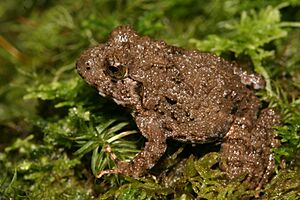Walkerana phrynoderma facts for kids
Quick facts for kids Walkerana phrynoderma |
|
|---|---|
 |
|
| Conservation status | |
| Scientific classification | |
| Synonyms | |
|
The Walkerana phrynoderma is a special kind of frog that lives only in the Anaimalai Hills. These hills are part of the Western Ghats mountain range in southern India, in the states of Kerala and Tamil nadu. You can find this frog in places like Munnar, Eravikulam National Park, and Anamalai Tiger Reserve. It also lives in Valparai tea gardens, Grass Hills National Park, and the Palni hills.
This frog is quite rare and lives on the ground, usually hidden in the fallen leaves of wet, tropical forests. It is considered one of the "Top 100 Evolutionarily Distinct and Globally Endangered Amphibians." This means it is very unique and important for nature, but it is also in danger of disappearing.
Contents
Where This Frog Lives
This frog has been seen in the Anamalai Hills and nearby parts of the Cardamom Hills. It is a nocturnal animal, meaning it is active mostly at night. It lives on the ground in forests and grasslands. Scientists have found these frogs near streams at high elevations, between 1,200 and 1,900 meters (about 3,900 to 6,200 feet) above sea level.
Life Cycle and Tadpoles
Most frog tadpoles live in water, but the tadpoles of the Walkerana phrynoderma are different. They do not live in ponds or streams. Instead, they move around on wet rocks and moss. They use their tails to help them move, and their back legs grow in much earlier than in other frog tadpoles. This special way of growing up helps them survive in their unique habitat.
Why This Frog Is Endangered
The International Union for Conservation of Nature (IUCN) lists this frog as endangered. This is because it lives in a very small area. Even though some of its habitat is in protected places like Anamalai Tiger Reserve, Eravikulam National Park, and Parambikulam Tiger Reserve, it still faces many threats.
Threats to Their Home
One big problem for these frogs is habitat loss. This happens when people collect wood for their homes or build new roads and buildings. These activities destroy the forests where the frogs live.
Other Dangers
- Pesticides: Runoff from nearby farms, which contains pesticides, can harm the frogs.
- Climate Change: Scientists think that climate change could also be a threat. Changes in monsoon weather patterns, which the frogs need to breed, could make it harder for them to survive.
- Fungus: Another possible threat is a fungus called Batrachochytrium dendrobatidis. This fungus causes a disease called chytridiomycosis, which can be deadly to amphibians. While scientists have not seen this fungus on Walkerana phrynoderma yet, they are watching out for it.


